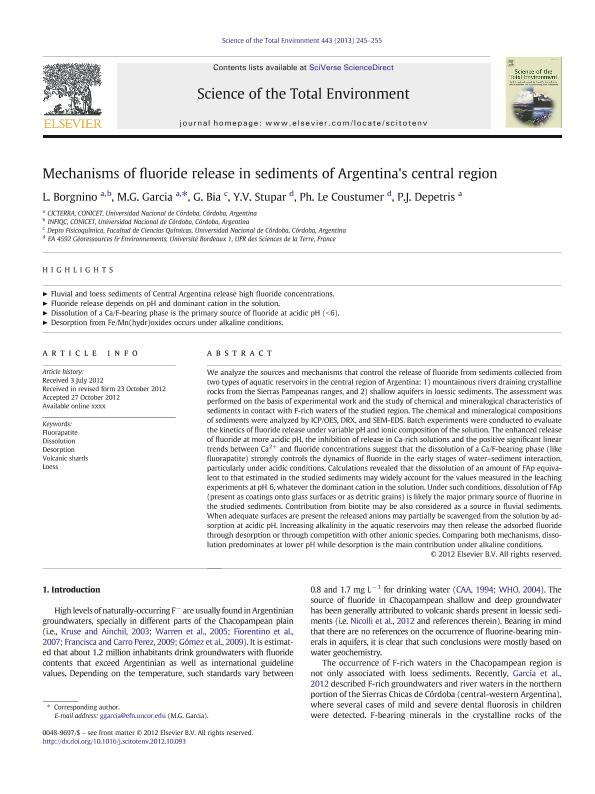Mostrar el registro sencillo del ítem
dc.contributor.author
Borgnino Bianchi, Laura Carolina

dc.contributor.author
Garcia, Maria Gabriela

dc.contributor.author
Bia, Gonzalo Luis

dc.contributor.author
Stupar, Y. V.
dc.contributor.author
Le Coustumer, Ph.
dc.contributor.author
Depetris Gallino, Pedro Jose

dc.date.available
2017-10-02T22:30:14Z
dc.date.issued
2012-11
dc.identifier.citation
Borgnino Bianchi, Laura Carolina; Garcia, Maria Gabriela; Bia, Gonzalo Luis; Stupar, Y. V.; Le Coustumer, Ph.; et al.; Mechanisms of fluoride release in sediments of Argentina's central region; Elsevier Science; Science of the Total Environment; 443; 11-2012; 245-255
dc.identifier.issn
0048-9697
dc.identifier.uri
http://hdl.handle.net/11336/25702
dc.description.abstract
We analyze the sources and mechanisms that control the release of fluoride from sediments collected from two types of aquatic reservoirs in the central region of Argentina: 1) mountainous rivers draining crystalline rocks from the Sierras Pampeanas ranges, and 2) shallow aquifers in loessic sediments. The assessment was performed on the basis of experimental work and the study of chemical and mineralogical characteristics of sediments in contact with F-rich waters of the studied region. The chemical and mineralogical compositions of sediments were analyzed by ICP/OES, DRX, and SEM-EDS. Batch experiments were conducted to evaluate the kinetics of fluoride release under variable pH and ionic composition of the solution. The enhanced release of fluoride at more acidic pH, the inhibition of release in Ca-rich solutions and the positive significant linear trends between Ca2+ and fluoride concentrations suggest that the dissolution of a Ca/F-bearing phase (like fluorapatite) strongly controls the dynamics of fluoride in the early stages of water–sediment interaction, particularly under acidic conditions. Calculations revealed that the dissolution of an amount of FAp equivalent to that estimated in the studied sediments may widely account for the values measured in the leaching experiments at pH 6, whatever the dominant cation in the solution. Under such conditions, dissolution of FAp (present as coatings onto glass surfaces or as detritic grains) is likely the major primary source of fluorine in the studied sediments. Contribution from biotite may be also considered as a source in fluvial sediments. When adequate surfaces are present the released anions may partially be scavenged from the solution by adsorption at acidic pH. Increasing alkalinity in the aquatic reservoirs may then release the adsorbed fluoride through desorption or through competition with other anionic species. Comparing both mechanisms, dissolution predominates at lower pH while desorption is the main contribution under alkaline conditions.
dc.format
application/pdf
dc.language.iso
eng
dc.publisher
Elsevier Science

dc.rights
info:eu-repo/semantics/openAccess
dc.rights.uri
https://creativecommons.org/licenses/by-nc-nd/2.5/ar/
dc.subject
Fluorapatite
dc.subject
Dissolution
dc.subject
Desorption
dc.subject
Volcani Shards
dc.subject.classification
Oceanografía, Hidrología, Recursos Hídricos

dc.subject.classification
Ciencias de la Tierra y relacionadas con el Medio Ambiente

dc.subject.classification
CIENCIAS NATURALES Y EXACTAS

dc.title
Mechanisms of fluoride release in sediments of Argentina's central region
dc.type
info:eu-repo/semantics/article
dc.type
info:ar-repo/semantics/artículo
dc.type
info:eu-repo/semantics/publishedVersion
dc.date.updated
2017-10-02T19:07:07Z
dc.journal.volume
443
dc.journal.pagination
245-255
dc.journal.pais
Países Bajos

dc.journal.ciudad
Amsterdam
dc.description.fil
Fil: Borgnino Bianchi, Laura Carolina. Consejo Nacional de Investigaciones Científicas y Técnicas. Centro Científico Tecnológico Conicet - Córdoba. Centro de Investigaciones en Ciencias de la Tierra. Universidad Nacional de Córdoba. Facultad de Ciencias Exactas Físicas y Naturales. Centro de Investigaciones en Ciencias de la Tierra; Argentina. Consejo Nacional de Investigaciones Científicas y Técnicas. Centro Científico Tecnológico Conicet - Córdoba. Instituto de Investigaciones en Físico-química de Córdoba. Universidad Nacional de Córdoba. Facultad de Ciencias Químicas. Instituto de Investigaciones en Físico-química de Córdoba; Argentina
dc.description.fil
Fil: Garcia, Maria Gabriela. Consejo Nacional de Investigaciones Científicas y Técnicas. Centro Científico Tecnológico Conicet - Córdoba. Centro de Investigaciones en Ciencias de la Tierra. Universidad Nacional de Córdoba. Facultad de Ciencias Exactas Físicas y Naturales. Centro de Investigaciones en Ciencias de la Tierra; Argentina
dc.description.fil
Fil: Bia, Gonzalo Luis. Consejo Nacional de Investigaciones Científicas y Técnicas. Centro Científico Tecnológico Conicet - Córdoba. Centro de Investigaciones en Ciencias de la Tierra. Universidad Nacional de Córdoba. Facultad de Ciencias Exactas Físicas y Naturales. Centro de Investigaciones en Ciencias de la Tierra; Argentina
dc.description.fil
Fil: Stupar, Y. V.. Universite de Bordeaux; Francia
dc.description.fil
Fil: Le Coustumer, Ph.. Universite de Bordeaux; Francia
dc.description.fil
Fil: Depetris Gallino, Pedro Jose. Consejo Nacional de Investigaciones Científicas y Técnicas. Centro Científico Tecnológico Conicet - Córdoba. Centro de Investigaciones en Ciencias de la Tierra. Universidad Nacional de Córdoba. Facultad de Ciencias Exactas Físicas y Naturales. Centro de Investigaciones en Ciencias de la Tierra; Argentina
dc.journal.title
Science of the Total Environment

dc.relation.alternativeid
info:eu-repo/semantics/altIdentifier/doi/http://dx.doi.org/10.1016/j.scitotenv.2012.10.093
dc.relation.alternativeid
info:eu-repo/semantics/altIdentifier/url/http://www.sciencedirect.com/science/article/pii/S0048969712013939
Archivos asociados
